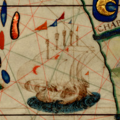File:Javanese or Sundanese jong in China Sea, from Miller Atlas of 1519.png
Javanese_or_Sundanese_jong_in_China_Sea,_from_Miller_Atlas_of_1519.png (266 × 432像素,文件大小:284 KB,MIME类型:image/png)
文件历史
点击某个日期/时间查看对应时刻的文件。
| 日期/时间 | 缩略图 | 大小 | 用户 | 备注 | |
|---|---|---|---|---|---|
| 当前 | 2019年11月3日 (日) 07:15 |  | 266 × 432(284 KB) | Verosaurus | {{Information |description ={{en|1=Cropped portion of China Sea, showing 2 large ships, one is six-masted and the other one, being shown from the aft, showing 3 masted ship (there could be more since the sails obstructed the front masts). Since it's showed inaccuracies with the description of Malay junk of the time, the image is clearly an attempt to depict a large Malay junk.}} |date =1519 |source =Lopo Homem-Reineis Atlas or Miller Atlas |author =Lopo Homem, Pedro... |
文件用途
以下页面使用本文件:
全域文件用途
以下其他wiki使用此文件:
- en.wikipedia.org上的用途
- es.wikipedia.org上的用途
- fr.wikipedia.org上的用途
- id.wikipedia.org上的用途
- ms.wikipedia.org上的用途
- mt.wikipedia.org上的用途
- uk.wikipedia.org上的用途




